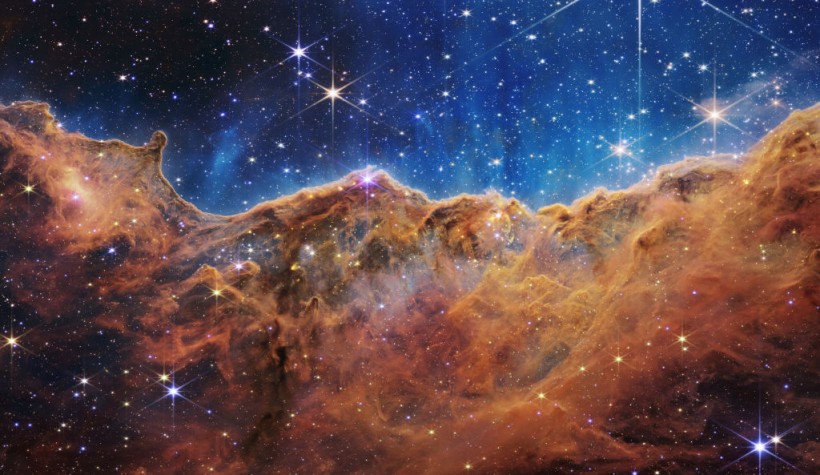Astronomers identified 24 previously unknown outflows from newborn stars in the 'Cosmic Cliffs,' an area within the stellar nursery NGC 3324, using one of the first photos from the James Webb Space Telescope.
They took a 'deep dive' into the massive clouds of gas and dust and were rewarded with a startling discovery: unmistakable signals of two dozen previously undiscovered young stars roughly 7,500 light years from Earth.

In this handout photo provided by NASA, a landscape of mountains and valleys speckled with glittering stars is actually the edge of a nearby, young, star-forming region called NGC 3324 in the Carina Nebula, on July 12, 2022 in space. Captured in infrared light by NASA's new James Webb Space Telescope, this image reveals for the first time previously invisible areas of star birth.
JWST Finds Hidden Newborn Stars
Everyone who saw the first images of JWST marveled back in July. Science Alert reported that the Cosmic Cliffs is one of them and is located at the edge of an active stellar nursery in NGC 3324 located near the Carina Nebula.
The picture depicts the tremendous ultraviolet energy emitted by bright newborn stars that shape the area, carving away vast gaps and leaving towers of gas that resist radiation.
In the study, titled "Deep diving off the 'Cosmic Cliffs': previously hidden outflows in NGC 3324 revealed by JWST" published in the Monthly Notices of the Royal Astronomical Society (MNRAS), researchers dug into the photo to learn more about the region and its star-formation activity.
This investigation was powered by the JWST's remarkable infrared capabilities that can focus on molecular hydrogen, the primary component of stars. The young stars are effective tracers for star-forming activity because they absorb hydrogen and release part of it in jets and polar outflows. This is known as stellar feedback, and the jets in the picture cut out caves in clouds of gas and dust.
The thick molecular clouds that generate them block the vision of young, still-forming protostars. However, the JWST has the ability to peer inside these clouds. One of the telescope's four primary science goals is to examine newborn stars within clouds.
NASA explained long before JWST was completed and launched that the space telescope can see right through into massive clouds of dust that may not be visible to other telescopes, like the Hubble Space Telescope. Today, the scientific community is seeing all of those promises coming true.
Understanding Star Formation One of the Quests of Astrophysics Today
The team's observations revealed a gallery of things ranging from modest fountains to burbling behemoths light-years away from the budding stars, Sci-News reported. Many of these protostars are on the verge of becoming low-mass stars like the Sun.
Researchers noted that the Webb provides a snapshot in time to see how much star formation is taking place in what may be a more typical part of the Universe that was unseen before.
Newborn stars gather material from surrounding gas and dust over their first 10,000 years. Most young stars release a percentage of that material back into space via jets that blast out from their poles in opposing directions. Dust and gas accumulate in front of the jets, which plow through the nebular clouds like snowplows.
Molecular hydrogen is swept up by these jets and seen in Webb's infrared photos. Nathan Smith of the University of Arizona explained that these jets are precursors to the most exciting part of star formation as they can only be seen in a limited period when young stars are actively accreting.
Understanding the mechanisms behind star formation is a major goal in astrophysics today because the earliest stars' collective light aided in the reionization of the early Universe.
RELATED ARTICLE: Previously Unseen Star Formation in Milky Way Detected in New Study
Check out more news and information on Space in Science Times.










!['Cosmic Glitch' in Einstein's Theory of General Relativity Could Be Explained in This New Scientific Tweak [Study]](https://1721181113.rsc.cdn77.org/data/thumbs/full/53435/258/146/50/40/cosmic-glitch-in-einsteins-theory-of-general-relativity-could-be-explained-in-this-new-scientific-tweak-study.jpeg)



